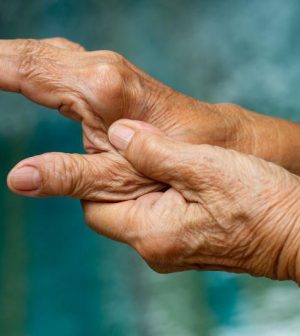- See What Saffron Can Do for Sleep and Heart Health
- 6 Common Mistakes to Avoid Before Your Physical
- Can Sweating Really Help You Beat a Cold?
- Strengthening Your Relationship: Practical Strategies
- Skip Storing This Everyday Product in the Fridge Door
- Green Tea + B3 Pairing May Boost Brain Health
- Navigating Your Midlife Crisis: Embracing New Possibilities
- City Raccoons Showing Signs of Domestication
- Mapping the Exposome: Science Broadens Focus to Environmental Disease Triggers
- One Week Less on Social Media Linked to Better Mental Health
Rheumatoid Arthritis: Types, Causes, Symptoms & Treatments

When you mention arthritis, most people think of osteoarthritis, where aging and wear-and-tear on the joints take their toll, but there is another type of arthritis that causes devastating damage after your immune system starts attacking your joints.
Rheumatoid arthritis is the most common form of autoimmune inflammatory arthritis, according to the Arthritis Foundation. Here’s what you need to know about rheumatoid arthritis, including its symptoms, types and treatments.
What is rheumatoid arthritis?
Rheumatoid arthritis (RA) is a chronic autoimmune disease that mostly affects joints. Commonly affected joints are the hands, knees or ankles. Usually both sides are affected. Over time, RA progresses and leaves patients with irreversible joint tissue damage, chronic pain, loss of function and deformities. Other areas of the body that may be involved are eyes, heart, circulatory system and/or the lungs.
Rheumatoid arthritis types
There are two main types of RA, seropositive and seronegative. When RA occurs in patients under 16, it is called Juvenile Idiopathic Arthritis.
Seropositive means your blood has two types of antibodies — anti-cyclic citrullinated peptides (anti-CCPs) and rheumatoid factor (RF) — which cause the symptoms of RA. Most people with RA have one or both of these antibodies. It is possible for these to show up in your blood tests anywhere from five to 10 years before symptoms appear.
Seronegative simply means that the anti-CCPs and RF do not show up in your blood. Doctors will look for other ways to determine if you have RA.
Rheumatoid arthritis causes
RA is the result of an immune response in which the body attacks its own healthy cells. While researchers don’t know why this occurs, studies show that it could be a combination of factors, including genes, environment (smoking) and sex hormones, according to the U.S. National Institute of Arthritis and Musculoskeletal and Skin Diseases (NIAMS).
Risk factors include family history, age, sex (women are more likely to have RA), previous joint injury and obesity, according to the Mayo Clinic.
A recent study published in the journal Science Translational Medicine determined that gut bacteria may be partly to blame as well.
Rheumatoid arthritis symptoms
The joint stiffness found in active RA is usually worse in the morning and may last two hours or more, according to the American College of Rheumatology. Movement usually helps loosen the joints.
Other RA symptoms include a loss of energy, low-grade fevers, poor appetite and firm lumps called rheumatoid nodules. These nodules grow beneath the skin in areas such as the elbows and hands.
According to the NIAMS, further medical problems that RA might cause are anemia, neck pain, and dry eyes and mouth. Some potentially serious symptoms are inflammation of the blood vessels, lung tissue, airways and the lining of the lungs. It can also cause inflammation in the sac around the heart (pericardium). Lung disease with scarring and inflammation of the lungs can be severe in some people.
Rheumatoid arthritis medications
The U.S. Centers for Disease Control and Prevention outlines effective treatments for RA, including medications and self-management strategies.
Rheumatoid arthritis medications include:
- DMARDs, which are disease-modifying anti-rheumatic drugs that slow the disease and prevent joint deformity.
- Biologicals, which provide an effective second-line treatment when the DMARDs don’t work or stop working.
Besides medications, people manage their RA with strategies to reduce pain and disability. These include:
- Staying active — more movement equals less stiffness.
- Watching your weight — to lower the strain on your joints.
- Maintaining regular doctor’s visits — to maximize your health.
- Protecting your joints — be careful with your activities.
Osteoarthritis vs. rheumatoid arthritis
What is the difference between rheumatoid arthritis and osteoarthritis? According to the Mayo Clinic, osteoarthritis, the most common form of arthritis, occurs when the cartilage that caps the bones in your joints wears away. Rheumatoid arthritis occurs when the immune system attacks the joints.
Another difference is the speed with which it advances. RA is known to progress quickly at the beginning and is progressive. It can be quite disabling and deforms joints into a bent position. Early intervention is critical.
On the other hand, osteoarthritis progresses slowly as you age. Repetitive activities that put a strain on the joints can lead to osteoarthritis. Old injuries can also be a factor. Osteoarthritis is sometimes hereditary and overweight people are more likely to experience this type, due to the strain on their joints.
“It’s important for a physician to figure out which arthritic condition you have because we have treatments to help put RA into remission,” rheumatologist Dr. David Fox, a professor at University of Michigan Medical School, said in a recent article.
While rheumatoid arthritis can be a life-altering diagnosis, with early treatment, careful management and a dedication to a few simple healthy living strategies, people with RA can increase their chances of living the full life they desire.
Source: HealthDay
Copyright © 2025 HealthDay. All rights reserved.










